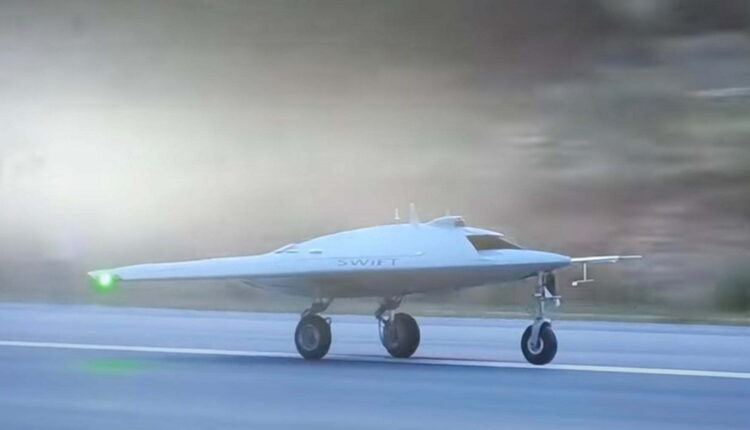©2021 Reporters Post24. All Rights Reserved.
India’s dreams of seeing its indigenous Ghatak (Lethal) Unmanned Combat Aerial Vehicle (UCAV) and fifth-gen AMCA fighter jet have come closer with the inaugural flight of the Autonomous Flying Wing Technology Demonstrator (AFW-TD) on Friday.
India’s Defense Research & Development Organization (DRDO) announced on Friday that the exercise was carried out at the Aeronautical Test Range, Chitradurga, Karnataka. Also called the Stealth Wing Flying Testbed (SWiFT), photos of it undergoing taxi trials surfaced last year.
Being a scaled-down version of India’s Ghatak UAV, the success and results from the AFW-TD/SWiFT will decide the former’s development trajectory.
Even more importantly, it will influence the large-scale fifth-generation stealth Advanced Medium Combat Aircraft (AMCA), which will have many overlapping and standard stealth features.
Called the Autonomous Unmanned Research Aircraft (AURA) around 2009, it was officially renamed Ghatak in 2015.
The release further said, “Operating in a fully autonomous mode, the aircraft exhibited a perfect flight, including take-off, waypoint navigation, and a smooth touchdown. This flight marks a major milestone in proving critical technologies towards the development of future unmanned aircraft and is a significant step towards self-reliance in such strategic defense technologies.” High-speed autonomous landing technology is another area being refined on the AFW-TD/SWiFT for the Ghatak.
Designed and developed by the Bengaluru-based Aeronautical Development Establishment (ADE), a premier research laboratory under the DRDO, the test-bed UAV aircraft is powered by a small turbofan engine.
The engine is reportedly a Russian turbofan made by NPO-Saturn. The UAV’s airframe, undercarriage/landing gear, flight controls, and avionics system were developed indigenously.
Other DRDO facilities are also involved in the project significantly – the Defense Electronics Research Laboratory and the Chennai-based Combat Vehicle Research and Development Establishment (CVRDE). The CVRDE claims to have supplied the project’s highly complex retractable landing gear.
Former Defense Minister AK Antony even stated in Parliament that a spin-off of the troubled Kaveri engine could act as a propulsion system for the Unmanned Strike Aerial Vehicle (USAV).
By 2015, the Aura project was redesignated as Ghatak. While the Aeronautical Development Establishment (ADE) was the lead organization for the project’s development, some fundamental research and development of significant technologies were conducted by the Indian Institute of Technology (IIT) Bombay and IIT-Kanpur.
One of these involves low-speed tests on the serpentine intakes of the Ghatak’s and wind tunnel testing of a low radar cross-section engine intake.
While there were offers from international aviation majors on some form of technical consultancy, especially regarding airframe design, avionics, flight control, or using offset components of larger planes manufactured in India, planners realized that the Low Observability/stealth technology would have to be entirely indigenous.
And this is where the overlap between the AFW-TD, the Ghatak UAV, and the Advanced Medium Combat Aircraft (AMCA) comes in.
The last two being stealth platforms, sources in the defense industry say the experience with the AFW-TD will guide the development of the other two, with a “substantial” commonality between the stealth technologies.
“SWiFT UAV is a Technology Demonstrator and is a scaled-down version of Ghatak UCAV (Unmanned Combat Air Vehicle). The main intent of SWiFT UAV is to demonstrate and prove the stealth technology and high-speed landing technology in autonomous mode,” the DRDO had said in an in-house bulletin.
“Based on the experience and domain expertise gained and milestones achieved in the design and development of LGS for 2-ton class UAV, landing gears for 25-ton class twin-engine Fighter Aircraft AMCA, has been taken up based on ADA’s requirements and design phase has started,” the bulletin added.
A scaled-up Ghatak will feature capabilities like network-centric data links, command and control, weapons carriage and release, fully autonomous uncrewed flights at longer ranges, satellite links, navigation systems, and electronics like electro-optical and flight control systems, target acquisition, and possibly Electronic Warfare (EW) suites.
Thrust-vectoring control is another mechanism being developed for overall aerodynamic and kinematic capability. The Ghatak is being tested as a full-scale model in a facility in South India for developing radar-wave deflecting and detection evasion technologies, which will also inform the development of radar-absorbent paints.
The Indian Air Force (IAF) participation will be essential here, given the service’s operational use of radars and their practical experience with how all the available radar systems in the country perform.
It has also been indicated that participation of private industry is substantial for developing built-to-specification models, airframes, and components for the prototypes for the long and arduous trial and error methods of developing radar cross-section (RCS) reduction features designs and shapes.


